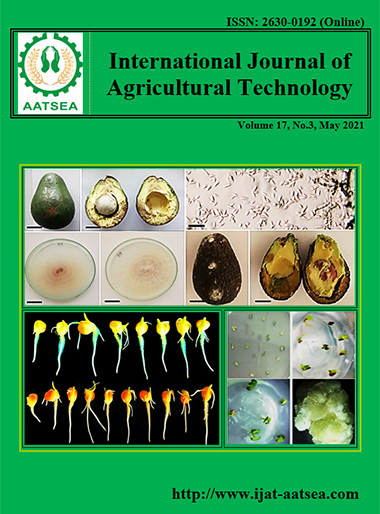Physico-chemical and microbiological properties of non-dairy yoghurt made from rice derivatives
Main Article Content
Abstract
The results showed that the addition of glucose and gelatinized rice flour improved growth of the lactic acid bacteria, improved the organoleptic properties of the yogurt and accelerated the acidification rate, with the greatest effect observed with gelatinized rice flour. The most effective combination, of those tested, was found that rice milk containing 5%, glucose together with 50% gelatinized rice flour for both NYC-A and NYC-B cultures. Levels of carbohydrate, protein, lipid, pH, acidity and lactic acid bacteria count were similar to levels in commercial soy, almond and coconut yoghurts sold in Thailand. No contamination from other microflora was detected throughout the storage period for both NYC-A and NYC-B yogurts and they were successfully stored for 28 days at 4°C without deterioration
Article Details

This work is licensed under a Creative Commons Attribution-NonCommercial-NoDerivatives 4.0 International License.
References
Adewale, B., Khadijat, A. and Nosimot, B. (2013). Rice-Coconut Yoghurt: Preparation, Nutritional and Sensory Qualities. Asian Journal of Agriculture and Rural Development, 3:924-928.
Alisa, F. (2020). Dairy-free yogurt reviews, Food and grocery, popular food guides product reviews. Retrieved from https://www.godairyfree.org/product-reviews/ best-dairy-free-yogurt-brands.
Amrane, A. (2001). Lactic acid production during the associated and the deceleration growth phases of Lactobacillus helveticus cultivated in various conditions and media. Dairy Science & Technology, 81:91-103.
AOAC (2002). Official methods of analysis of AOAC. Gaithersburg, MD: AOAC Intl.
Bansal, S., Mangal, M., Sharma, S. K., Yadav, D. N. and Gupta, R. K. (2016). Optimization of process conditions for developing yoghurt like probiotic product from peanut. Lwt, 73:6-12.
Bernat, N., Chafera, M., Chiralt, A. and Martnez, G. (2015). Probiotic fermented almond “milk” as an alternative to cow-milk yoghurt. International Journal of Food Studies, 4:201-211.
Cáceres, P. J., Peñas, E., Martínez-Villaluenga, C., García-Mora, P. and Frías, J. (2019). Development of a multifunctional yogurt-like product from germinated brown rice. LWT, 99:306-312.
Chalupa-Krebzdak, S., Long, C. J. and Bohrer, B. M. (2018). Nutrient density and nutritional value of milk and plant-based milk alternatives. International Dairy Journal, 87:84-92.
Chandan, R. C., Gandhi, A. and Shah, N. P. (2017). Chapter 1 - Yogurt: Historical Background, Health Benefits, and Global Trade. In N. P. Shah (Ed.), Yogurt in Health and Disease Prevention, pp.3-29.
Coda, R., Lanera, A., Trani, A., Gobbetti, M. and Di Cagno, R. (2012). Yogurt-like beverages made of a mixture of cereals, soy and grape must: microbiology, texture, nutritional and sensory properties. Int J Food Microbiol, 155:120-127.
Corrieu, G. and Béal, C. (2016). Yogurt: The Product and its Manufacture. Encyclopedia of Food and Health, 5:617-624.
Froiio, F., Cristiano, M. C., Mancuso, A., Iannone, M. and Paolino, D. (2020). Vegetable-Milk-Based Yogurt-Like Structure: Rheological Properties Influenced by Gluten-Free Carob Seed Flour. Applied Sciences, 10:6963.
Gallo, M., Nigro, F., Passannanti, F., Salameh, D., Schiattarella, P., Budelli, A. and Nigro, R.(2019). Lactic fermentation of cereal flour: feasibility tests on rice, oat and wheat. Applied Food Biotechnology, 6:165-172.
Ibrahim, A. I., Naufalin, R., Erminawati. and Dwiyanti, H. (2019). Effect of fermentation temperature and culture concentration on microbial and physicochemical properties of cow and goat milk yogurt. IOP Conference Series: Earth and Environmental Science, 406:012009.
Ito, V. C. and Lacerda, L. G. (2019). Black rice (Oryza sativa L.): A review of its historical aspects, chemical composition, nutritional and functional properties, and applications and processing technologies. Food Chemistry, 301:125304.
Kim, S. and Dale, B. E. (2004). Global potential bioethanol production from wasted crops and crop residues. Biomass and Bioenergy, 26:361-375.
Kim, S., Lim, C., Lee, C. and An, G. (2009). Optimization of growth and storage conditions for lactic acid bacteria in yogurt and frozen yogurt. Journal of the Korean Society for Applied Biological Chemistry, 52:76-79.
Leahy, E., Lyons, S. and Tol, R. (2010). An estimate of the number of vegetarians in the world. ESRI working papers, 340:1-44
Luana, N., Rossana, C., Curiel, J. A., Kaisa, P., Marco, G. and Rizzello, C. G. (2014). Manufacture and characterization of a yogurt-like beverage made with oat flakes fermented by selected lactic acid bacteria. Int J Food Microbiol, 185:17-26.
Magala, M., Kohajdová, Z., Karovičová, J., Greifová, M. and Hojerová, J. (2015). Application of lactic acid bacteria for production of fermented beverages based on rice flour. Czech Journal of Food Sciences, 33:458-463.
Mohammadi-Gouraji, E., Soleimanian-Zad, S. and Ghiaci, M. (2019). Phycocyanin-enriched yogurt and its antibacterial and physicochemical properties during 21 days of storage. LWT, 102:230-236.
Nagpal, R., Kumar, A., Kumar, M., Behare, P. V., Jain, S. and Yadav, H. (2012). Probiotics, their health benefits and applications for developing healthier foods: a review. FEMS Microbiology Letters, 334:1-15.
Plengsaengsri, P., Pimsuwan, T., Wiriya-Aree, T., Luecha, J., Nualkaekul, S and Deetae, P. (2019). Optimization of process conditions for the development of rice milk by using response surface methodology. IOP Conference Series: Earth and Environmental Science, 346:012-080.
Salmerón, I., Thomas, K. and Pandiella, S. S. (2015). Effect of potentially probiotic lactic acid bacteria on the physicochemical composition and acceptance of fermented cereal beverages. Journal of Functional Foods, 15:106-115.
Sert, D., Mercan, E. and Dertli, E. (2017). Characterization of lactic acid bacteria from yogurt-like product fermented with pine cone and determination of their role on physicochemical, textural and microbiological properties of product. LWT, 78:70-76.
Sodini, I., Lucas, A., Oliveira, M. N., Remeuf, F. and Corrieu, G. (2002). Effect of Milk Base and Starter Culture on Acidification, Texture, and Probiotic Cell Counts in Fermented Milk Processing. Journal of Dairy Science, 85:2479-2488.
Sowcharoensuk, C. (2019). Industry Outlook 2019-2021: Rice Industry. Retrieved from https://www.krungsri.com/en/research/industry/industryoutlook/ Agriculture/Rice/IO/io-rice-20.
Turgut, T. and Cakmakci, S. (2017). Probiotic Strawberry Yogurts: Microbiological, Chemical and Sensory Properties. Probiotics and Antimicrobial Proteins, 10:64-70.
Wongkhalaung, C. and Boonyaratanakornkit, M. (2000). Development of a Yogurt-type Product from Saccharified Rice. Kasetsart Journal : Natural Science, 34:107-116.
Zare, F., Boye, J. I., Orsat, V., Champagne, C. and Simpson, B. K. (2011). Microbial, physical and sensory properties of yogurt supplemented with lentil flour. Food Research International, 44:2482-2488.


